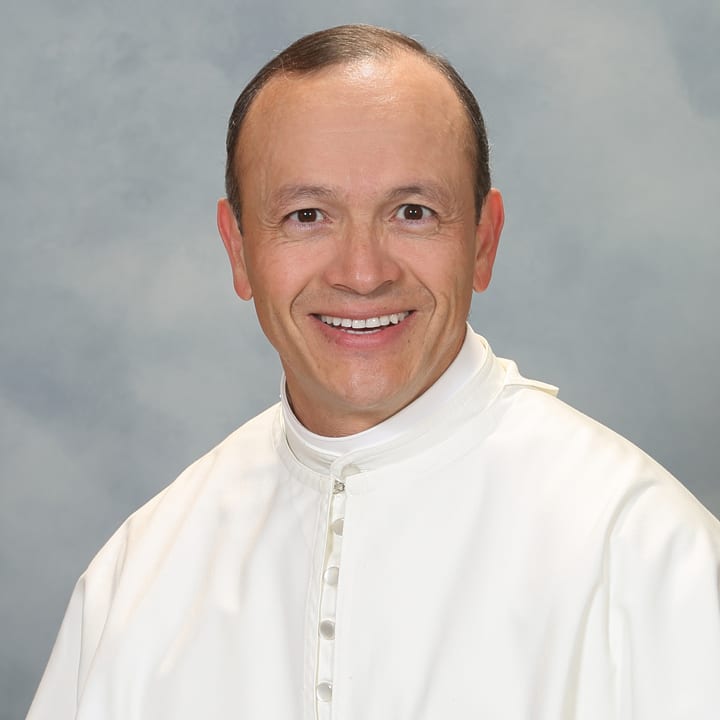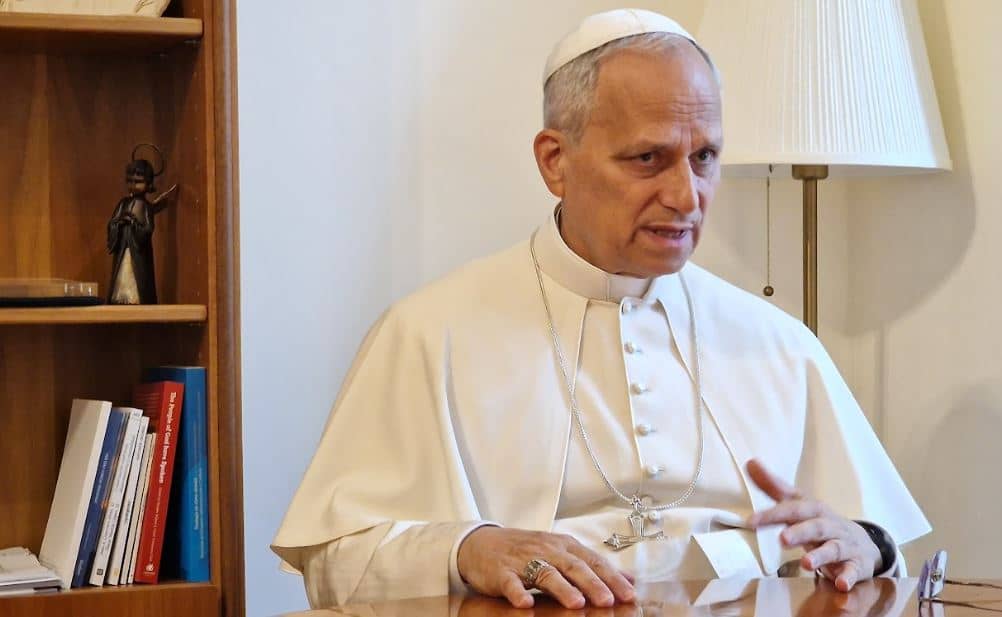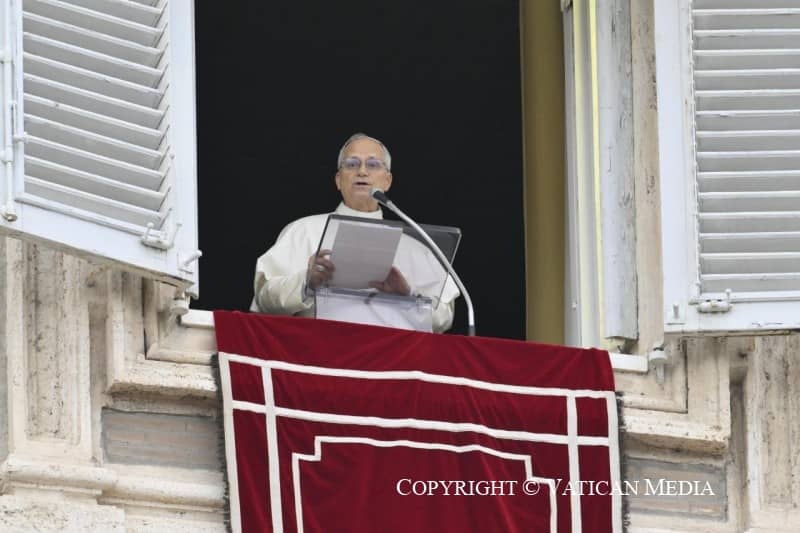[Editor’s Note: Nobertine Father Justin S. Ramos entered the Norbertine community of St. Michael’s Abbey in Orange County, California in 1987. He completed his priestly studies at the Pontifical Universities Santa Croce and Angelicum in Rome, was ordained 1995, and currently works for the St. Michael’s Abbey Foundation. Showing genuine leadership in his thinking about the spirituality of giving, he has been instrumental in raising over $130 million to construct a new abbey that will accommodate the dramatic growth in vocations that St. Michael’s Abbey continues to experience He spoke to Charles Camosy.]
Camosy: 900 years for the Norbertines! What are some highlights for the order over those nine centuries?
Ramos: On May 28, 1115, St. Norbert, a worldly and mediocre cleric, was thrown from his horse in a violent thunderstorm and heard God’s call to conversion. One man, one moment, gave birth to an Order and kindled a flame that has endured 900 years. St. Norbert’s Order, which started on December 25, 1121 in Prémontré, France, focused on reform of priestly life. In 1124 the preaching and example of St. Norbert and a small group of his confreres converted the entire city of Antwerp back to a true love and devotion for the Holy Eucharist after having been led astray for many years by the errors of the heretic Tanchelm (d.1115). St. Norbert’s embrace of the long-neglected Rule of St. Augustine as the guide for his priestly-monastic communities (“canons regular”) inaugurated a true revival of Augustinian monasticism and brought Augustine’s Rule back into the prominence it still enjoys today in the landscape of consecrated life in the West today.
By the middle of the 13th century there were five hundred Norbertine abbeys with over ten thousand members: a milestone reached by only a handful of religious orders in the long history of the Catholic Church. In 1627, at a time when the Catholic faith was rapidly disappearing from much of the landscape of Europe, including Bohemia, the translation of the mortal remains of St. Norbert to the abbey of Strahov in Prague (where they still rest today) became the catalyst for a massive reconversion of the people of Bohemia to their traditional Catholic roots.
In spite of taking massive hits along the way from historical developments such as the Protestant revolt, the French revolution, and the secularization of what was once Christendom, the Norbertine Order is one of only five religious orders which have persevered long enough to celebrate 900 years of uninterrupted service to Christ and His Holy Church.
I hear there’s a new Abbey coming to mark the occasion. Can you tell us a bit about it?
By God’s Providence we’re opening a new Norbertine Abbey in Silverado, California to mark the 900 years of the Order of Prémontré. This reveals at least two things:
1) that our canonical life, priests living in a monastery following a rule of life, not only survives the test of time but is thriving in Southern California; we have a full abbey of priests and close to forty (40) young seminarians studying for the priesthood;
2) The beautiful abbey structure that has been built is the external manifestation of a deep life of prayer and pastoral care of souls rooted in the tradition of the early Christian apostolic community and monastic life: Acts of the Apostles 4:32 (The multitude of believers was of one mind and heart. No one claimed anything of their own but held all things in common.)
The original abbey was founded by seven canons who fled their native land during the Communist takeover of Hungary in the late 1950s. The blessings of many vocations led us to outgrow the abbey and necessitated a larger abbey to accommodate the growing community. And even now at the new abbey we are at full capacity with close to 100 members. The miracle in this story is that a small, hidden, almost unknown ancient religious community in Southern California was able to raise over $130 million to build a monastery and a gorgeous Romanesque church from a relatively small number of committed friends who believed in the ideal of the canonical religious life of St. Michael. God can never be outdone in generosity! We were set to open the new Abbey sooner, but because of covid-19 and two major fires in 2020, we postponed the opening until now.

However, it’s profound that God had us wait until 2021: 1) 2021 marks the 900th anniversary of the Norbertine Order. 2) This is the year of St. Joseph, under whose protection we confided our building project many years earlier.
I also hear there is commissioned art coming in from around the world. Can you give us a sense of what kind of art and from where?
The Church is the House of God and the Gate of heaven. It is the most important structure of the entire abbey and will be where we and all visitors can lift up our souls and hearts in prayer, so we chose the Roman basilica architectural style to show our connection and adherence to the See of Peter and the ancient classical tradition.
Remaining faithful to the Christian tradition of hopeful awaiting of the coming of Christ on the Last Day, the Church is oriented towards the east, the rising of the sun, the dayspring from on High, with a vaulted barrel ceiling soaring seventy feet high. It’s height is only surpassed by the bell tower (over 100 feet) with a peal of four bells from a ninth generation family owned bell maker, Paccard in Annecy, Auvergne-Rhône-Alpes France.
The colorful and bright blown stained glass made in France was brought to the family owned Judson Studios founded in 1897 in Highland Park, California, where the non-figurative designs were made. The tabernacle was modelled upon the altar piece found in the church of San Miguel de Aralar in Navarre, Spain. It is said to have been a gift from Richard the Lionheart to Sancho IV, King of Navarre while seeking his daughter Berengaria’s hand in marriage. The gold surface is decorated with Limoge enamels of The Mother of God depicted on the door and the Patriarchs of the Old Testament. The crucifix in the abbey church and statues of the saints in the crypt are all polychrome carved and polychromed by an Imaginero from Cordoba, Spain.
All the stone altars were quarried and made in Spain. The nave shrines will depict secco paintings of the saints including Ss. Michael, Joseph, Francis, Anthony and others all painted directly on the walls by Italian Iconographers from Perugia. The jewel of all the art in the abbey church is the Venetian mosaic of Our Lady of the Assumption on the Triumphal Arch and east apse that depicts Our Lady (17 feet tall), with the Archangels Michael and Gabriel, the Cherubim and Seraphim, angels sounding the trumpet for the last Judgment, the rising of the dead, garlands, vines, fruits, flowers etc in the Ravenna mosaic style and the inscription from Revelation 12: A great sign appeared in the sky; a woman clothed with the sun with the moon under her feet and on her head a crown of twelve stars. The apsidal shrines will also be mosaics from Venice of Our Lady of Guadalupe and St. John the Baptist. The radiant shimmering gold of the mosaics will illuminate the walls, ceilings and hearts of all.
I grew up in Wisconsin and folks in my circles all knew about St. Nobert’s College and I was happy to visit friends there a few times. Is there a Norbertine philosophy of education? Maybe one that can speak to our current disruptions and uncertainties?
St. Norbert’s vision of education is permeated with the Catholic faith, immersed in God’s Word, anchored in the great tradition of the Church, and accompanied by a profound life of prayer. St. Norbert’s own conversion led him to understand that the best way to bring others to holiness was to be holy oneself —since one cannot give what he does not have.
To this end he founded the Norbertine order to reform the clergy; in this way his followers could offer a lived out example of a pure sacrifice of their lives to God.
The heart of the Norbertine vocation is the fitting worship of Christ in the Eucharist. Hence all our apostolic endeavors aim at this one goal: to lead people to Jesus in the Eucharist. Education in the Norbertine tradition therefore involves both enlightening the mind and purifying the heart for fitting worship through a strong moral formation through prayer, the sacraments, and right instruction in the commandments. A person who generously and sincerely allows himself to be formed in this way is disposed to benefit from the fruits of Holy Mass.
Beyond education, where do you see the order going into the future?
The Canons Regular of Prémontré are not identified with one apostolic work or “Charism.” Rather, following the exhortation of St. Paul to Timothy “If any man shall cleanse himself …, he shall be a vessel of honor, sanctified and profitable to the Lord, prepared for every good work” (2 Tim 2:21). Our service to God’s people is rooted in our consecration to Jesus Christ and formed by our common life of liturgical prayer that is organized according to the prayer of the Church: The Holy Sacrifice of the Mass and the Liturgy of the Hours. “Seven times a day I praise You,” says the Psalmist. By chanting together the prayers of the Divine Office in the ancient Gregorian chant, Norbertine canons continue the monastic tradition and “continually offer up a sacrifice of praise to God.”
For more than sixty years, St. Michael’s Abbey has served the Christian faithful in Southern California—“lifting high the Holy Eucharist over the miseries and errors of this world” (St. John Paul II). Our community’s apostolic ministries are many and various— from priests operating parishes and teaching in schools to chaplains to colleges and communities of religious women. Some of our confreres write books and articles, while others have ministries through the internet and radio. We celebrate the sacraments and teach religious education in prisons, youth facilities, hospitals, and nursing homes. Our abbey is the site of numerous retreats and Bible studies, as well as a popular summer camp run by our seminarians.
The new abbey is again bursting at the seams as God continues to bless us with worthy young men who desire to lay down their lives for Christ. Starting a new foundation in the near future and using the current means of mass communication to spread the gospel are a couple of ways to impact the future of our society. We have already begun the Abbot’s Circle which has a vast digital library of Catholic content that will spiritually nourish a thirsty soul.
















